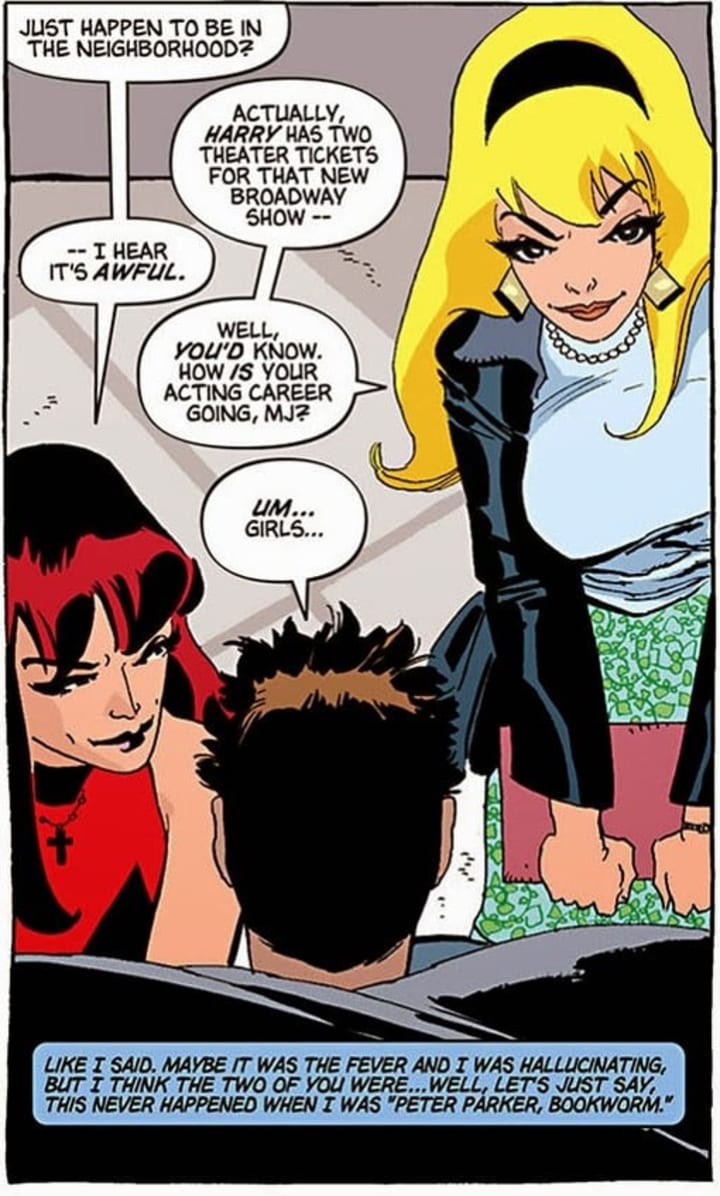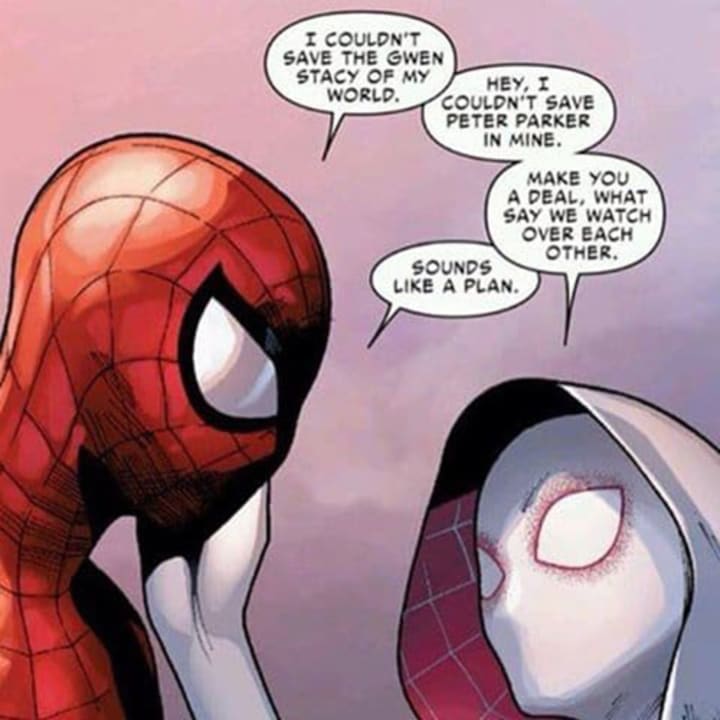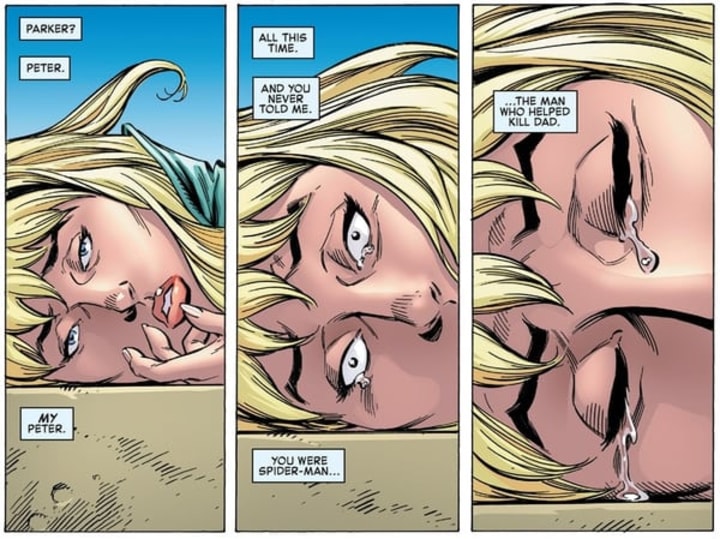
In 1973, comics changed forever. Amazing Spider-Man #121-122 saw an iconic plot in which Gwen Stacy — the love of Peter Parker's life — was tragically killed. It's seen as the moment when the Silver Age of comics ended, and the Bronze Age — one of increasing social relevance and far darker plots — began. But who is Gwen Stacy? Why did her death have such an impact? And how have comics and films revisited that death in the years since?
Who Is Gwen Stacy?

A haunting image, with Gwen caught in Spider-Man's webs. Image: Sony
Created by Stan Lee and Steve Ditko, Gwen Stacy was introduced in Amazing Spider-Man #31 as a potential love interest for Spider-Man. As Sean Howe observes in his book Marvel Comics: The Untold Story, Gwen bears all the hallmarks of a Stan Lee love interest: he always had a thing for blondes, and his later wife resembled Gwen more than a little!
Gwen was presented as a milestone in Peter Parker's growth as a character. He'd just graduated from college, and was going on to take his first steps as an adult; Gwen played the role of his first real love, in contrast to the teenage crushes that had gone before her. It was when John Romita Jr. took over the artwork in Amazing Spider-Man #39 that Gwen really began to come into her own, though; Romita ditched Ditko's more straight-laced portrayal, and soon Gwen had become a warmer, more passionate personality. Only a few issues later, Gwen got competition; in Amazing Spider-Man #42 we were introduced to one Mary-Jane Watson.

Enter Gwen's competition! Image: Marvel Comics
Gwen and Mary-Jane essentially played the classic "good girl" / "bad girl" roles, creating an entertaining love triangle in which Peter had to choose between Gwen and Mary-Jane. The problem with this kind of love triangle is that it can't go on forever, and when Stan Lee stepped away from the book, it was left to relative newcomer Gerry Conway to resolve it.
The Death of Gwen Stacy

Spider-Man's grief. Image: Marvel Comics
For Gerry Conway, the real problem was that Spider-Man is about tragedy — and settling him down with "good girl" Gwen Stacy would inevitably bring those tragic themes to an end. What's more, Conway wasn't really a fan of Gwen's character; he much preferred Mary-Jane's. So it was that Conway decided to take the comics in a radical direction, and have Gwen Stacy killed.
Matters came to a head in Amazing Spider-Man #121, with Gwen kidnapped by the Green Goblin. Spider-Man and the Green Goblin confronted one another atop the George Washington Bridge (although the art actually showed the Brooklyn Bridge). Gwen's prone body was knocked off the side of the bridge; Spider-Man desperately launched a rescue, his web-lines sweeping out to catch her body. Unheard by Spider-Man, but visible to readers, the lettering including a small sound as the web-lines caught Gwen.
SNAP.
The clear implication (which was later confirmed in the letters pages) was that the sudden shock as those webs caught her body had snapped Gwen's neck, instantly killing her. Far from saving his girlfriend, Peter Parker's very attempt to rescue her had resulted in her death.
A Transforming Moment for Comics

The Green Goblin strikes! Image: Marvel Comics
Nothing like this had ever been done in comics before. Superheroes were supposed to save the day; now, tragically, one superhero's attempt to do good had caused the death of the woman he loved! As Ben Saunders writes in Do the Gods Wear Capes?:
"When Gwen dies, despite and perhaps because of his best efforts, the relationship between guilt and responsibility central to Peter Parker's self-understanding is exposed as a self-protective fiction - keeping at bay the awareness that we live in an unpredictable universe where Bad Things happen that no one can prevent."
In narrative terms, it was a touch of genius: exposing the core of Spider-Man's 'power and responsibility' ethic and facing it with its greatest challenge. For readers, too, this was a ground-shaking moment; readers who escaped to comics to avoid those harsh truths were suddenly being faced with them. This one arc brought an end to the Silver Age of comics, and ushered in the Bronze Age — one with darker plot elements, real-world issues such as racism and drug abuse, and a recurring awareness of tragedy. Comic books grew up.
Bring Back Gwen!

The clone goes on her way. Image: Marvel Comics
With comic book readers reeling, Conway was under real pressure to somehow work a resurrection miracle over in the Spider-Man books. His strange attempt was to introduce a clone in Amazing Spider-Man #142; but this plot only amplified the heartbreak of losing a character like Gwen. Although the clone wanted to simply resume her life, Peter & Gwen's friends reacted in shock and horror. This "original clone saga" came to a head in Amazing Spider-Man #149, with the clone leaving after an emotional final conversation with Peter. It was also Gerry Conway's final issue on the book, his run essentially now defined by the death of Gwen Stacy.
Conway would continue to circle around Gwen's death for years. In the 1980s, while writing Spectacular Spider-Man, he'd reveal that the clone was actually a woman who'd been genetically modified so as to torture Spider-Man's emotions; the retcon just made the whole thing even more awkward and uncomfortable. The Gwen Stacy clone would eventually become a major part of the infamous "Clone Saga", an arc that dominated Spider-Man comics in the mid-1990s.
Remembering Gwen Stacy

Peter remembers those early days. Image: Marvel Comics
Comics have always honored Gwen Stacy's death, never more poignantly than in the beautiful Spider-Man: Blue series. Released in 2003 and written by Jeph Loeb, with stunning art by Tim Sale, Spider-Man: Blue featured the Peter of the present day looking back, haunted once again by the death of Gwen. It's heartbreaking, showing an adult who remembers his years as a bumbling teenager, and wishes he'd made different decisions. The plot is all the more emotionally disturbing because, in the comics, Peter had married Mary-Jane — but even a happy marriage had been unable to dull the edge of Peter's grief. Mary-Jane discovers Peter making tapes where he revisits Gwen's death, and joins him in his sorrow; she admits that she still misses Gwen too.
In 2005, Marvel launched the "House of M" event in which the Scarlet Witch recreated reality, granting countless superheroes their heart's desire. In a twist that's perfectly in-character, and yet somehow deeply disturbing, the Spider-Man - House of M miniseries gave us a Peter Parker who was happily married to Gwen Stacy. When the Scarlet Witch's spell is finally rewritten, Peter is one of a handful of superheroes who retain their memories of this altered reality. It's a sickening twist, meaning Peter experiences the loss of Gwen yet again — and, this time, he also experiences the loss of their child.
Although Gwen didn't really play a major role in the Sam Raimi trilogy, 2012's Amazing Spider-Man reboot starred Emma Stone as Gwen Stacy. The outcome was never in doubt, and her fate was sealed in 2014's Amazing Spider-Man 2. The films introduced a wider audience to a version of Gwen Stacy, rekindling the character's popularity, but also exposing viewers to the tragedy of Gwen Stacy. The final death scene was beautifully done, and served as a fitting homage to the original that will always be a real fan-favorite. Ironically, though, it lacked the emotional power of the original death. This is the problem when a character's arc mirrors a comic book so closely; everybody was expecting it.
Spider-Gwen

Spider-Man and Spider-Gwen. Image: Marvel Comics
2014 saw Gwen's story take an unexpected turn, though. Dan Slott was plotting an event called "Spider-Verse", uniting various alternate-reality versions of Spider-Man in battle against a multi-dimensional threat. With interest in Gwen at a fresh high thanks to the movies, he tossed out the idea of an alternate reality where Gwen Stacy was the one bitten by a radioactive spider. The idea was picked up by Jason Latour and Robbi Rodriguez, who created a new Spider-Woman.
Marvel never expected the character to be so popular. Rodriguez's beautiful design went viral, and Twitter dubbed the character Spider-Gwen. The name has stuck, and Spider-Gwen was soon launched into her own ongoing series.

Stunning fan-art of Spider-Gwen! Image: DeviantArt - Art of Carmen
Spider-Gwen is perhaps the most fascinating exploration of Gwen Stacy. The character is similar enough to the 'real' Gwen to resonate with fans, but different enough to stand as her own character. In an inspired move, Latour avoided the cliche of having Peter and Gwen wind up together in this reality; for Spider-Gwen, the tragic event that inspired her heroism was the death of Peter Parker. She became a fascinating, if distorted, reflection of the Spider-Man we know and love. The character's been successful enough to recently debut in the Ultimate Spider-Man animated series, voiced by Dove Cameron, and there are real fan hopes that the character will eventually make her way into the MCU.
Dead No More

Last week saw the launch of "Dead No More", the next Spider-Man event. The concept of "Dead No More" is simple; the Jackal, Spider-Man's clone-master nemesis, has resurrected Peter Parker's loved ones. Unlike previous clones, though, these retain the memories of the original, raising the haunting possibility that the Jackal has somehow restored their souls.
Dead No More: The Clone Conspiracy #1 wasted no time in twisting the knife. We were introduced to the resurrected Gwen Stacy, and - in a heart-wrenching supplementary story - we revisited her death. That issue revealed that Gwen was conscious atop the Brooklyn Bridge, and heard the Green Goblin and Spider-Man talking as they fought. Shockingly, she realized that Peter was in fact Spider-Man — the superhero she blamed for her father's death. She did not die at peace; instead, at the moment she fell from the bridge her heart was breaking at Peter's betrayal. It's a subtle rewrite of Gerry Conway's original story, but it packs a devastating emotional punch. Wherever "Dead No More" goes next, that retcon will remain, adding yet more tragedy to Gwen Stacy's life and death.
As you can see, the death of Gwen Stacy is a moment that will always define Spider-Man. It transformed the comic book industry, bringing readers face-to-face with the reality of grief and loss. Because of that tremendous emotional impact, it's a plot that comics will never truly move on from. The wound is always fresh, always new, and always painful. And yet, precisely because of its emotional power, I view the death of Gwen Stacy as one of the most powerful moments in comic book history. It's a reminder that comics aren't just mindless entertainment — they're a vehicle that can be used to explore the depths of human experience.
About the Creator
Tom Bacon
A prolific writer and film fan, Tom has a deep love of the superhero genre.






Comments
There are no comments for this story
Be the first to respond and start the conversation.